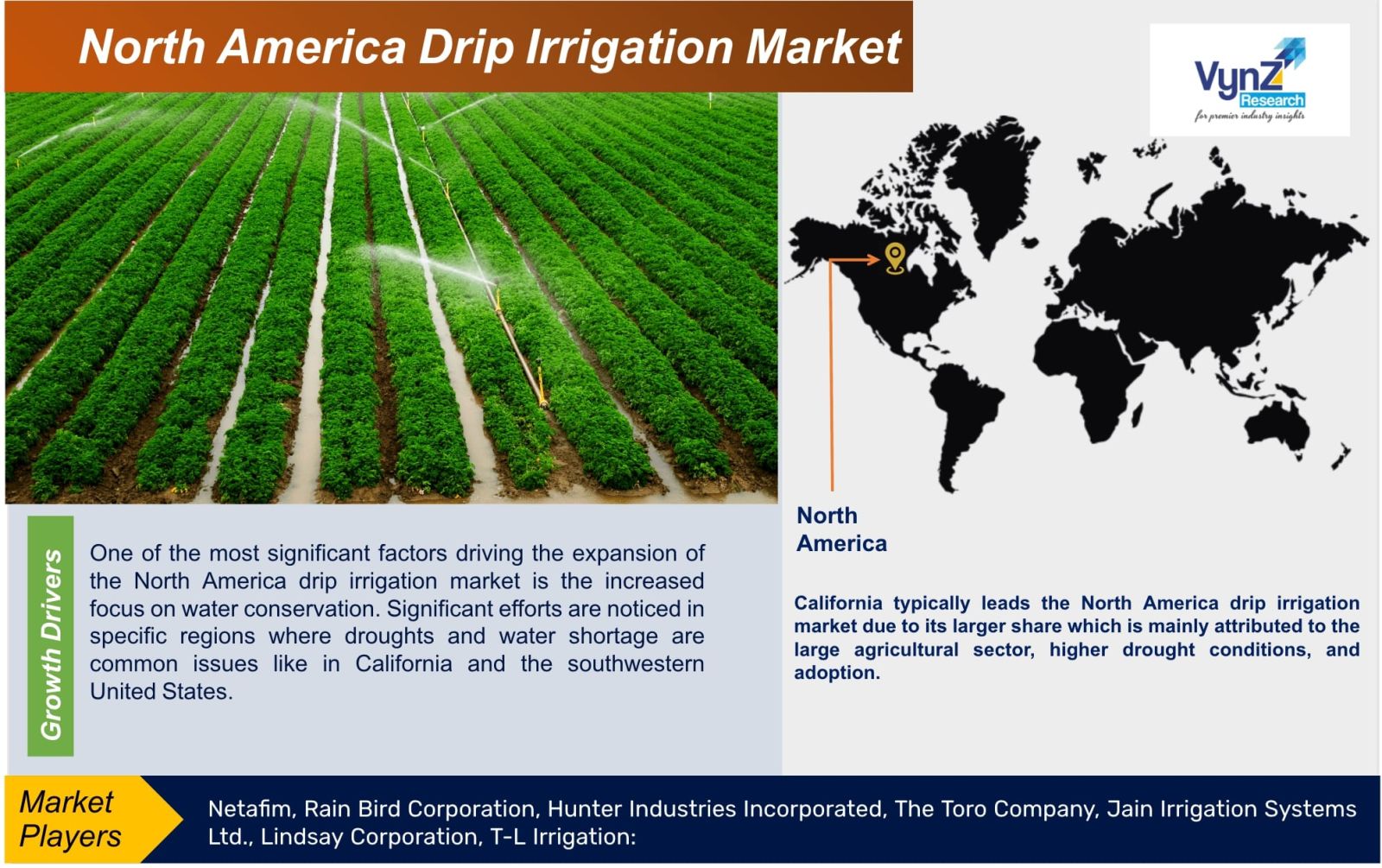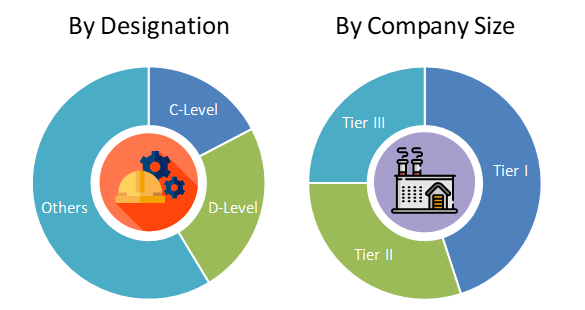North America Drip Irrigation Market Size & Share | Growth Forecast Report 2030
Industry Insights By Crop Type (Field Crops, Fruits and Nuts, Vegetable Crops, and Other Crops), By Application Type (Surface and Subsurface Systems), By Emitter Type (Inline and Online Emitters), By Components (Emitters/Drippers, Pressure Pumps, Drip Tubes/Drip Lines, Valves, Filters, and Fittings and Accessories segments) and By Geography (California, Texas, Floridais).
| Status : Published | Published On : Oct, 2024 | Report Code : VRFB11029 | Industry : Food & Beverage | Available Format :

|
Page : 90 |
North America Drip Irrigation Market Size & Share | Growth Forecast Report 2030
Industry Insights By Crop Type (Field Crops, Fruits and Nuts, Vegetable Crops, and Other Crops), By Application Type (Surface and Subsurface Systems), By Emitter Type (Inline and Online Emitters), By Components (Emitters/Drippers, Pressure Pumps, Drip Tubes/Drip Lines, Valves, Filters, and Fittings and Accessories segments) and By Geography (California, Texas, Floridais).
Industry Overview
The North America Drip Irrigation market size was valued at USD 2.2 billion in 2023. It is likely to grow up to USD 5.4 billion by 2030 at a CAGR of 12.8 % during the forecast period ranging between 2025 and 2030.The growing adoption of sustainable landscaping solutions apart from agriculture is one significant factor driving the growth of this market in this region. This is notably reflected in residential, commercial, and public landscaping projects as it is an ecofriendly solution to maintain gardens, lawns, and other green spaces while preserving water.

Drip irrigation refers to the highly effective system for watering plants. The system comprises tubes, pipes, and emitters. This mechanism supplies water directly to the roots of the plants. With such regulated and targeted irrigation, wastage of water is significantly reduced. It also increases crop production and lowers operational cost. This technology is extremely useful in water-scarce and drought-prone areas. It is used extensively in agriculture, horticulture, and landscaping purposes.
North America Drip Irrigation Market Report Coverage
|
Report Metric |
Details |
|
Historical Period |
2020 - 2024 |
|
Base Year Considered |
2025 |
|
Forecast Period |
2026 - 2035 |
|
Market Size in 2025 |
U.S.D. 2.2 Billion |
|
Revenue Forecast in 2035 |
U.S.D. 5.4 Billion |
|
Growth Rate |
12.8% |
|
Segments Covered in the Report |
By Crop Type, By Application Type, By Emitter Type and By Components |
|
Report Scope |
Market Trends, Drivers, and Restraints; Revenue Estimation and Forecast; Segmentation Analysis; Impact of COVID-19; Companies’ Strategic Developments; Market Share Analysis of Key Players; Company Profiling |
|
Regions Covered in the Report |
California, Texas and Floridais |
North America Drip Irrigation Industry Dynamics
North America Drip Irrigation Market Trends/ Growth Drivers:
Growing efforts for water conservation is driving the adoption of drip irrigation
One of the most significant factors driving the expansion of the North America drip irrigation market is the increased focus on water conservation. Significant efforts are noticed in specific regions where droughts and water shortage are common issues like in California and the southwestern United States.
In addition, supportive government initiatives, policies, and grants like Environmental Quality Incentives Program (EQIP) aimed at promoting sustainable agriculture and the rise in demand for more efficient irrigation in agriculture for higher productivity with lower operational costs and better resource utilization is also affecting the market growth in a positive way.
A few other factors that drive the market growth include the growing popularity of precision agriculture, expansion of horticulture, growing need for high-value crops, technological advancements, regulatory compressions on water usage in agriculture, climate change, growth in organic farming and greenhouses, higher agricultural infrastructure investments, and growing awareness among consumers of sustainable agriculture.
North America Drip Irrigation Market Challenges
Water usage regulations and compliance issues
One of the major challenges faced by the North America drip irrigation market which hinders its expansion significantly is the complex water usage regulation and the issues related to compliance. The rules are extremely strict in a few specific regions that are considered to be drought-prone. This complicates the adoption and application of drip irrigation systems into agriculture. Adding to the complexity and confusion is the potentially frequent changes made in these guidelines. This causes uncertainty and enhances the probability of financial risks.
North America Drip Irrigation Market Opportunities
Growth of precision agriculture
The North America drip irrigation market is poised for growth during the forecast period due to the significant growth of precision agriculture practices. The farmers today look for tech-driven solutions and adopt them to maximize resource management and crop production. This makes drip irrigation systems essential today due to their higher efficiency with the incorporation of smart technologies, such as sensors and automated controls. This not only assures higher water efficiency and reduced wastage but also enhances crop health providing excellent growth opportunities to the market.
Recent Devlopments By the Key Players
Bayer and Netafim, have collaborated with new digital farming solutions for fruit and vegetable growers. The new solutions shall help growers maximise crop production and optimise their use of resources which shall minimise the impact on the environment.
North America Drip Irrigation Market Segmentation
VynZ Research provides an analysis of the key trends in each segment of the North America Drip Irrigation Market report, along with forecasts at the global, regional and country levels from 2025-2030. Our report has categorized the market based on crop type, application type, emitter type and component.
Insight by Crop Type
- Field Crops
- Fruits and Nuts
- Vegetable Crops
- Other Crops
The field crops segment dominates the market due to its extensive use
The North America drip irrigation market is segmented by crop type into Field Crops, Fruits and Nuts, Vegetable Crops, and other crops, such as Turf, Ornamental Plants, and Spice Crops. Out of all these segments, the field crops segment dominates the market and is expected to grow at a higher CAGR during the forecast period due to extensive use among farmers and the growing need for efficient irrigation solutions. The growth is also attributed to the lower operational costs, higher profit margins, and enhanced water management capabilities.
Insight by Application Type
- Surface
- Subsurface Systems
Surface systems lead the market due to greater versatility and effectiveness in cash crop cultivation
According to the application types, the North America drip irrigation market is further categorized into Surface and Subsurface Systems, where the surface systems segment dominates the market due to their higher versatility and effectiveness in cash crop cultivation. It is also driven by other factors such as the rising demand for cash crops, growing need for high productivity, ease of installation, lower maintenance costs, and higher accessibility.
Insight by Emitter Type
- Inline
- Online Emitters
Inline emitters dominate the market because of their higher efficiency and ease of installation
The North America drip irrigation market is divided by the emitter types into Inline and Online Emitters. Out of these two, the inline emitters segment dominates the market due to their higher efficiency and ease of installation. Moreover, their specific design and mechanism reduces issues with clogging, enhances performance, offers higher reliability, optimizes water use, improves crop yields, and rising preference for precision agriculture.
Insight by Components
- Emitters/Drippers
- Pressure Pumps
- Drip Tubes/Drip Lines
- Valves
- Filters
- Fittings and Accessories
Emitters/drippers segment leads the market due to their higher efficiency
The different components of drip irrigation systems divide the North America drip irrigation market into Emitters/Drippers, Pressure Pumps, Drip Tubes/Drip Lines, Valves, Filters, and Fittings and Accessories segments. Out of these the emitters/drippers segment leads the market due to their higher efficiency in water flow control, higher irrigation efficiency, and growing emphasis on maximizing crop production.
North America Drip Irrigation Market: Geographic Overview
- U.S.
- Canada
- Mexico
California typically leads the North America drip irrigation market due to its larger share which is mainly attributed to the large agricultural sector, higher drought conditions, and adoption.
Texas follows closely, showing better growth promises due to the diverse agricultural landscape, growing focus on sustainable practices, and growing demand for efficient water management solutions.
Floridais also showing significant growth prospects due to higher adoption in the horticultural industry, vegetable and fruit cultivation practices, apart from the enhanced focus on water conservation and favorable climate.
North America Drip Irrigation Market Competitive Insight:
- Netafim
- Rain Bird Corporation
- Hunter Industries Incorporated
- The Toro Company
- Jain Irrigation Systems Ltd.
- Lindsay Corporation
- T-L Irrigation
PRIMARY RESEARCH INTERVIEWS - BREAKDOWN

Frequently Asked Questions
Purchase Options
Latest Report
Research Methodology
- Desk Research / Pilot Interviews
- Build Market Size Model
- Research and Analysis
- Final Deliverabvle
Connect With Our Sales Team
- Toll-Free: 1 888 253 3960
- Phone: +91 9960 288 381
- Email: enquiry@vynzresearch.com
North America Drip Irrigation Market
